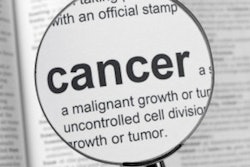
Participation in CT lung cancer screening programs among eligible individuals in the U.S. has been making modest gains over the past several years. The U.S. Centers for Disease Control and Prevention (CDC) released on February 28 new survey findings with statewide rates as high as 16%.
Low engagement in screening services among high-risk smokers has long been a concern for the early detection of lung cancer. Since the U.S. Centers for Medicare and Medicaid Services approved reimbursement for CT lung screening more than half a decade ago, uptake for the exam has hovered around 2% to 4%. An analysis of the U.S. National Health Interview Survey estimated a participation rate of 3.9% in 2015, and a separate study found that the rate had dipped to 1.9% in 2016 based on data from the American College of Radiology Lung Cancer Screening Registry.
For the current report, Dr. Thomas Richards and colleagues at the CDC analyzed the organization's 2017 Behavioral Risk Factor Surveillance System (BRFSS) telephone survey, which collected information on health-related risk behaviors, disease prevalence, and use of preventive services in 10 different states. In 2017, the BRFSS survey for the first time included questions on smoking history and participation in CT lung screening exams (Morbidity and Mortality Weekly Report, February 28, 2020, Vol. 69:8, pp. 201-206).
The group examined responses to the BRFSS survey from 85,514 individuals. In all, 12.7% of respondents met the U.S. Preventive Services Task Force (USPSTF) eligibility requirements for lung screening. The task force recommends screening for adults ages 55 to 80 who have a smoking history of 30 or more pack-years and still smoke or quit fewer than 15 years ago.
Among screening-eligible individuals, only 12.5% claimed to have received a CT lung screening exam in the past year. About half of these individuals were former smokers. The participation rates varied widely by state, from 9.7% in Oklahoma to 16% in Florida.
| CT lung screening participation rates by state in 2017 | ||
| Projected number of screening-eligible individuals | % of individuals who participated in screening | |
| Florida | 610,000 | 16% |
| Vermont | 16,200 | 13.5% |
| Maryland | 106,300 | 11.2% |
| Missouri | 206,600 | 10.5% |
| Kansas | 76,800 | 10.5% |
| Oklahoma | 126,200 | 9.7% |
| Georgia | 179,000 | - |
| Nevada | 74,400 | - |
| Maine | 43,400 | - |
| Wyoming | 16,600 | - |
For smokers who met the screening eligibility criteria, factors associated with an increased likelihood of participation included diagnosis of chronic obstructive pulmonary disorder and having had a routine medical checkup in the past year.
The researchers also discovered that a small proportion of individuals (7.9%) had undergone CT lung screening despite not meeting USPSTF eligibility requirements. The participation rates among these respondents ranged from 4.3% in Maryland to 9.4% in Florida and Oklahoma.
The findings could enable researchers to identify which states may benefit most from outreach efforts, the CDC noted. In addition, developing more effective measures for educating healthcare providers on the benefits of CT lung screening and providing decision support tools might help increase appropriate and timely screening.
"Public health initiatives to prevent cigarette smoking, increase smoking cessation, and increase [CT] lung cancer screening among those who meet USPSTF criteria could help reduce lung cancer mortality," the CDC said.




















